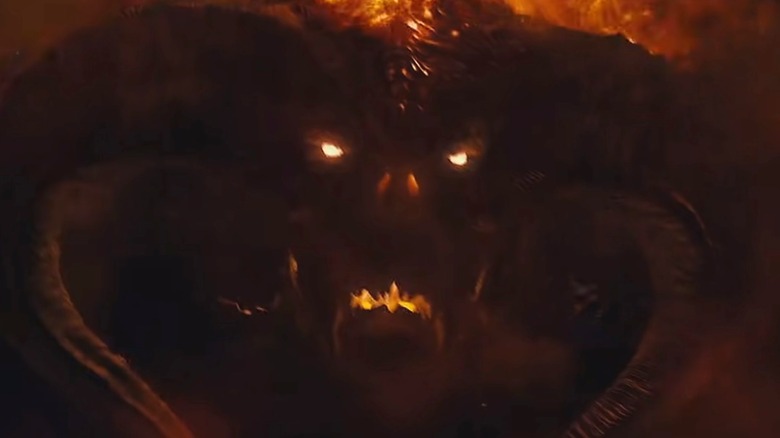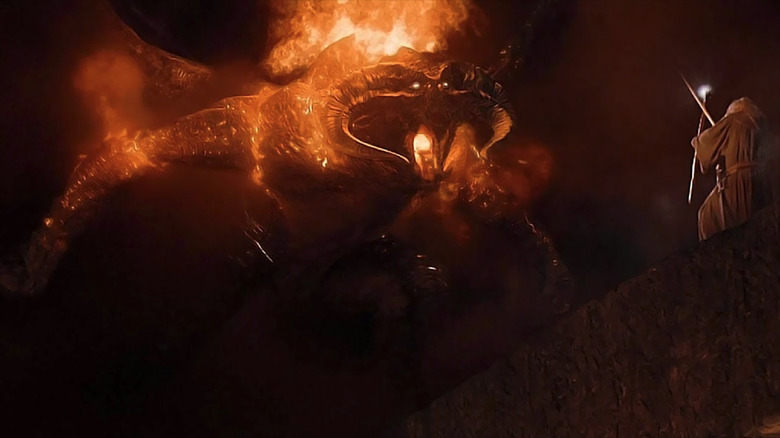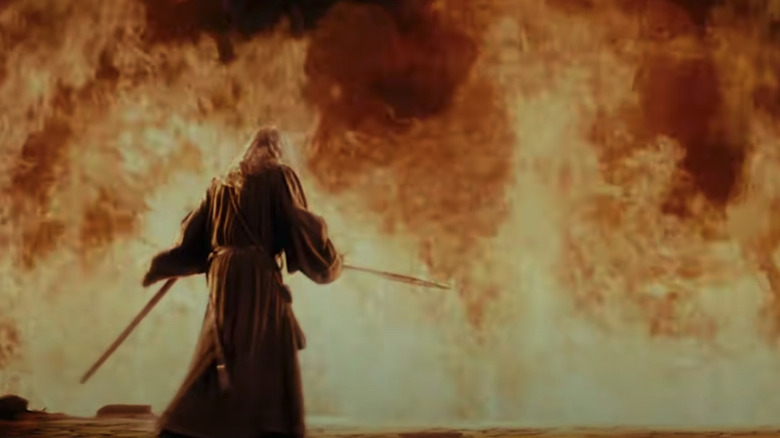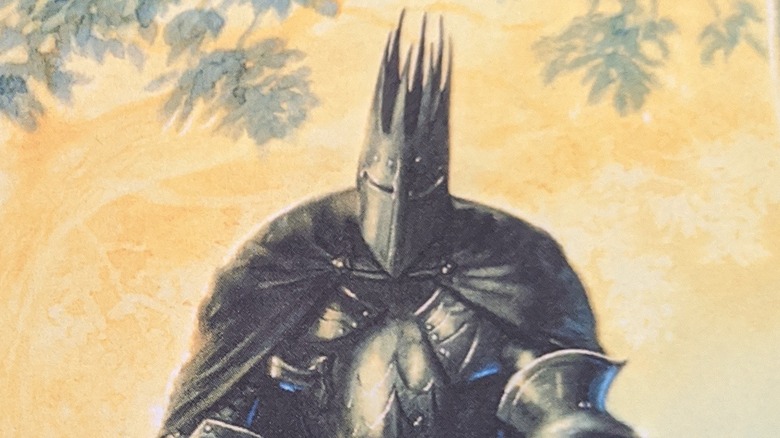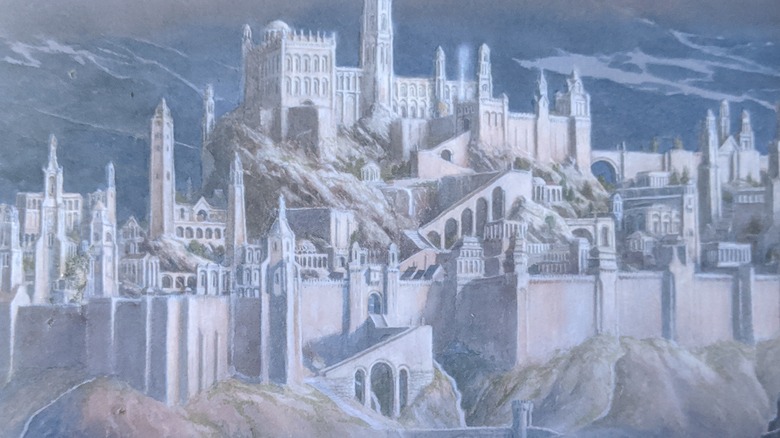What Are The Balrogs? Explaining Tolkien's Middle-Earth Monsters
Middle-earth is filled with countless wonders. Even if you're only looking at the evil side of the ledger, there are endless spectacles. There are grisly Orcs, towering Trolls, spine-chilling ringwraiths, and of course, the Dark Lord Sauron himself. In spite of all the other horrific sights to see, though, it's still a monstrous shock the first time that a Balrog steps onto the scene. It doesn't matter if you're reading or watching, the fiery presence of the demon of Moria is palpable from the first moment it enters the story.
The Balrog in "The Fellowship of the Ring" is unnerving. It also happens to lead to one of the best moments in the entire story. Gandalf takes down the creature, hurtles into the deep with it, chases it to the top of the mountains, and then throws it down again onto the mountainside during the Battle of the Peak. After that, the wizard is recycled into Gandalf the White and heads back into the fray with Sauron. And the Balrog? Yeah, it drops out of the story entirely. In fact, from that point on, no more Balrogs show up at all. Zip. Zero. Nada.
Of course, this leaves the burning question: What the heck was that thing? What is a Balrog? Why is there only one of them? Is it sentient or bestial? Why is it on fire? And the age-old question: Was that a wing or just a shadow? With Amazon's prequel Middle-earth series set to expand on all things Middle-earth, we decided to do a little fleshing out ourselves, particularly in the area of Balrogs. And it didn't take long to realize that these things are freaking insane. Here's a quick primer on one of the most fearsome groups (that's right, there's more than one of them) to ever traipse across Tolkien's creation.
Balrogs have ancient and immortal beginnings
Let's start from, well, the start, shall we? No, for real. We need to step way back in time for this one. Balrogs get their start at the very beginning of Middle-earth's obscurely ancient history. They're initially created as a part of the race of angelic spirits known as the Ainur. Eventually, a large portion of these spirits descend into Arda (the world) and become known as the Maiar.
While many of the Maiar remain good guys, a faction of them break off and join the original Dark Lord Morgoth. These become known as the Valaraukar. "The Silmarillion" exposits that these baddies were "the scourges of fire that in Middle-earth were called the Balrogs, demons of terror." The book also explains that the word "Balrog" translates as "Demon of Might" — which, yeah, no kidding.
"The Silmarillion" also explains that early on in the story, Morgoth "gathered his demons about him, those spirits who first adhered to him in the days of his splendour, and became most like him in his corruption." The text goes on to explain that these dreadful spirits' "hearts were of fire, but they were cloaked in darkness, and terror went before them; they had whips of flame. Balrogs they were named in Middle-earth in later days." So, at their core, Balrogs are literally spiritual demons of terror that physically manifest as gigantic, demonic monsters.
It's this spiritual dimension that makes Balrogs so inaccessible as a part of Tolkien's legendarium. The author himself often writes about them as if they are beyond his full comprehension. This naturally creates a sense of terrifying awe that goes much further than the fiery surface. It also goes a long way in explaining Gandalf's response to the arrival of the demon in "The Fellowship of the Ring" when he states "A Balrog ... now I understand ... What an evil fortune! And I am already weary."
How many Balrogs are there?
Understanding the disquieting reality of what Balrogs are is a bit disconcerting. After all, they aren't like Orcs or even Trolls. You can't just shoot one with an arrow or stab it with a spear and be on your way. It takes powerfully spiritual beings like Gandalf to truly take one down. As uncomfortable as a Balrog's makeup is, though, at least we have a good idea of what that substance is.
One nut that is much harder to crack is figuring out how many of the blasted creatures there are running around at any given moment. Tolkien is infamous for endlessly rewriting drafts of his stories, and the Balrogs tend to evolve throughout the different versions.
At first, they're referred to by the hundreds and even the thousands. They also seem to have been a bit weaker, as they often are killed in battle by mere Elves and Men. However, over time, Tolkien started to level them up. As the author fleshed out his world more thoroughly, he made the demons fiercer, cleverer, and more leadership-oriented. As they increased in power, they also began to dwindle in numbers.
One of the last notes that Tolkien ever wrote about Balrogs is recorded in the encyclopedic "History of Middle-earth" volume titled "Morgoth's Ring." In it, Tolkien's son Christopher comments that his father had left a note on a later text about Balrogs, stating that "There should not be supposed more than say 3 or at most 7 ever existed."
This leaves the final count of the monsters very much so on the lower end of the spectrum. While the specific number of Balrogs ended low, though, there's no doubt that it remained in flux throughout Tolkien's writings, with the author himself never being quite sure about the size of the supernatural population.
Balrogs are loyal servants
Alright, at this point, we know that Balrogs are demons and that they've been around from the beginning of time. That begs the question: Where are they all when "The Lord of the Rings" kicks off? Why is there just one badass demon lurking under a mountain somewhere?
It turns out that the Balrogs are a rather rare commodity by the time the main trilogy rolls around. This is because most of the spiritual servants of darkness don't survive their heyday — which takes place either in or before the First Age of Middle-earth history. (For reference, "LOTR" happens at the end of the Third Age, several thousand years later.)
In this earlier portion of history, Balrogs tend to show up often, and every time that they do, they show a remarkable loyalty to their master, Morgoth. For instance, at one point Morgoth is captured and held prisoner for a few thousand years. Rather than heading off on their own, though, the Balrogs literally sit tight, hiding and waiting for their master to return. When he does show up again, he has a showdown with the monstrous arachnoid spirit Ungoliant. When Morgoth is overpowered, he cries out, and guess who comes to his rescue? You guessed it: his Balrogs.
After that, the Balrogs show up regularly in the wars that Morgoth wages with the Elves, Men, Dwarves, Maiar, and other free peoples of Middle-earth. They serve as bodyguards around the Dark Lord's throne, lead his armies in battle, and carry out his nefarious deeds throughout the 500-year-long First Age. Every time a Balrog is mentioned, it's always used as a tool to raise the stakes, cranking the threat level of any situation up to 11.
Gothmog and a deadly duel
Balrogs are usually brought up in a generic way. They're referred to, either individually or as a group, merely as "Balrogs." While they are certainly sentient, spiritual, and ancient, Tolkien never gives any of them names, identities, or personalities — with one exception.
Gothmog is the one named Balrog in all of Middle-earth's lengthy mythos. The character is referred to as the Lord of Balrogs and serves as the primary captain of Morgoth's dungeon fortress of Angband. He's described as having a bodyguard made of Trolls, and he single-handedly is recorded killing not one, not two, but three different Elven lords. This may sound underwhelming for a fiery demon, but the Elves of the First Age are highly spiritual beings who regularly go toe-to-toe with other supernatural creatures. In fact, it's in battle with the last of these Elf-lords, a fella named Ecthelion, that Gothmog himself is killed.
Gothmog dies during the epic destruction of the hidden Elven city of Gondolin (pictured). This happens toward the end of the First Age. Interestingly, it's also during that conflict that another Balrog gets some special attention, too — even if this one still isn't important enough to get a name.
When Gondolin is destroyed, the survivors of the city escape through a mountain pass. However, as they flee, they're ambushed by Orcs ... led by a Balrog. This leads to an insane duel between the fiery demon and the Elf warrior Glorfindel. The pair duke it out up on top of a mountain until both of them hurtle into the depths below to their death. (And for fans of the "LOTR" books, yes this is the same Glorfindel – reincarnated, of course — that helps Frodo get to Rivendell.)
Durin's Bane
At the end of the First Age, Morgoth is overthrown in the War of Wrath. Most of his servants are destroyed, and "The Silmarillion" informs us that the Dark Lord himself is "thrust through the Door of Night beyond the Walls of the World, into the Timeless Void." Which, yeah, talk about an ending.
While Morgoth is shouldered out of the story, though, many of his servants survive the apocalyptic battle and scatter across Middle-earth. This sets the stage for the Second Age, where we officially see Sauron rise as the new Dark Lord. At this point, the attention primarily shifts to Sauron and Rings of Power, but there are still some Balrogs lurking here and there. In fact, "The Silmarillion" states that Men are still "troubled by many evil things that Morgoth had devised in the days of his dominion: demons, and dragons, and misshapen beasts, and the unclean Orcs..." The reference to "demons" seems to imply that Balrogs were still occasionally causing some trouble.
However, for the most part, it's here that the demonic race more or less disappears from the history books. The survivors lie in hiding until the Dwarves accidentally bump into one below their thriving colony of Khazad-dûm nearly 2,000 years into the Third Age. Eventually dubbed "Durin's Bane," this unearthed Balrog destroys the entire Dwarven kingdom and remains in control of the subterranean mansion until Gandalf shows up 1,000 years later.
Once the Balrog in Moria is killed, we don't hear of the demons anymore. They are all destroyed or so deeply hidden that they never appear in the history again. And that, in a nutshell, is the history of Balrogs — and for those of you who were wondering, no, we're not about to dive into the question of whether or not Balrogs have wings. That ambiguously cryptic debate will have to wait for another time.
